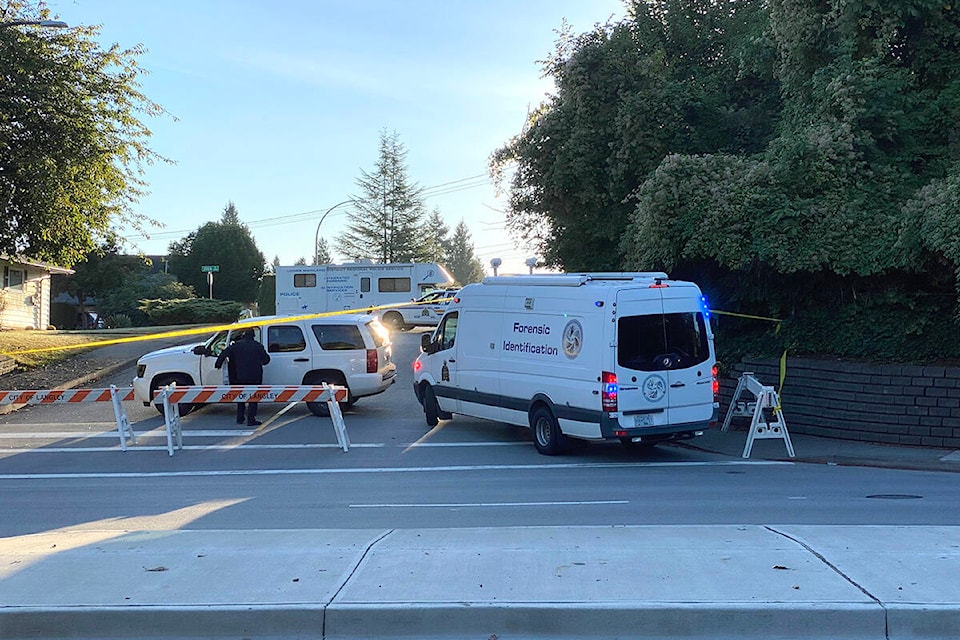WARNING: This story contains disturbing content
Langley RCMP violated the rights of a man now accused of manslaughter during a brief initial arrest – but not during a search of his yard that uncovered human remains, a BC Supreme Court judge has ruled.
Obnes Regis is in custody awaiting trial for the death of his wife, Naomi Onotera, who vanished in the summer of 2021, causing an extensive search by the public, as well as a police investigation.
Between October and November of 2023, Regis was in New Westminster Supreme Court for a lengthy voir dire hearing. This type of hearing can determine which evidence can be used in a trial.
Persons charged with a criminal offence are considered not guilty until the charges are proven in court.
READ MORE:
The voir dire hearing centered on police interactions with Regis in the two weeks following Onotera’s disappearance.
Onotera’s mother called 911 to report her daughter missing on the evening of Aug. 29, 2021 just before 7 p.m., Justice Martha Devlin noted in her ruling. No one had seen or heard from Onotera since the previous night.
Later that evening, Langley RCMP officers met with Onotera’s sister at the home Onotera shared with Regis near 200th Street and 50th Avenue in Langley City.
The sister told the officers that she had already been inside, and had found her sister’s purse, key and cellphone, and hadn’t been able to get in touch with Regis since he had left the home the day before.
Officers entered the home to confirm Onotera was not there and to conduct a search. Police believed the search was justified without a warrant or permission from the owner, because it was an emergency situation. Police can enter homes without warrants when it is for lifesaving purposes.
Several officers searched the home over the next few hours.
Devlin found that despite the 911 call and the missing persons report, at the time they arrived, officers “had no information that Ms. Onotera was at risk” when they began the first search.
The judge also found that a 15-minute detention of Regis by Langley RCMP was a second violation of his rights.
Regis arrived back at the home, on foot, at 6:30 a.m.
Two RCMP officers who had been stationed there to secure the scene testified during the voir dire that they had been instructed that if Regis turned up, they were to ensure he didn’t leave.
They handcuffed Regis, told him he was being detained for investigation into his wife’s disappearance, and put him in an RCMP vehicle.
When a more senior investigator arrived 15 minutes later, he immediately had Regis taken out of cuffs and made it clear that he was not under arrest.
Regis was then asked if he would go to the Langley RCMP detachment to talk to investigators about his wife’s disappearance – they told him he was considered a witness and not a suspect.
He went willingly and spoke at length to an investigator with the Langley RCMP Serious Crimes Unit.
The Crown prosecutors acknowledged that the 15-minute detention in the police cruiser violated Regis’s rights, but argued that the following interview did not.
Devlin agreed.
“Mr. Regis was not a suspect; he was a valuable source of information for the police regarding his missing wife, and was treated as such,” Devlin wrote in her ruling.
She also found that later searches of the home were constitutional, as Regis agreed to allow police into the building, including with a police dog.
According to a recording of the Aug. 30 interview with police, an investigator said they wanted to look for any evidence that could help them find Onotera.
“Let’s go right now,” Regis replied.
He would later agree to let police search Onotera’s car as well as providing them with her toothbrush and hairbrush for DNA samples.
Importantly, Devlin found that a police dog search on Sept. 13, which discovered human remains in the yard, was valid.
On Sept. 13, Langley RCMP arrived at the home with two police dogs, Kimber and Kitt, both of whom had been trained to detect cadavers. They would indicate if they smelled human remains by lying down.
Kitt was taken to nearby parks where there had been reports of dogs acting strangely, while Kimber was led through the house and its yard.
Before the search, police explained Regis’s rights, including that he could stop the search at any time, and he signed a form allowing it.
“In the northwest corner of the yard, near a collection of children’s toys, there was an electric mitre saw on the grass, plugged in via a cord to the house,” Devlin wrote. “PSD [Police Service Dog] Kimber made an indication near the saw.”
An officer testified at the voir dire that he picked up something in the area after two indications by Kimber. The item had strands of hair on it – officers believed it was a piece of human remains. It tested positive for blood.
After that discovery, homicide investigators were called in, and on Sept. 15, Regis was told he was now a suspect in his wife’s killing.
During the voir dire, Regis’s lawyers attempted to argue that he didn’t have enough information to give informed consent to the Sept. 13 search by police dogs. Devlin rejected that argument, finding that the police had thoroughly explained to him about the search, and had told him that the dogs were trained to look for cadavers.
The voir dire rulings will set the stage for what evidence from the searches can be introduced at the trial, currently scheduled to begin in May in BC Supreme Court in New Westminster.



